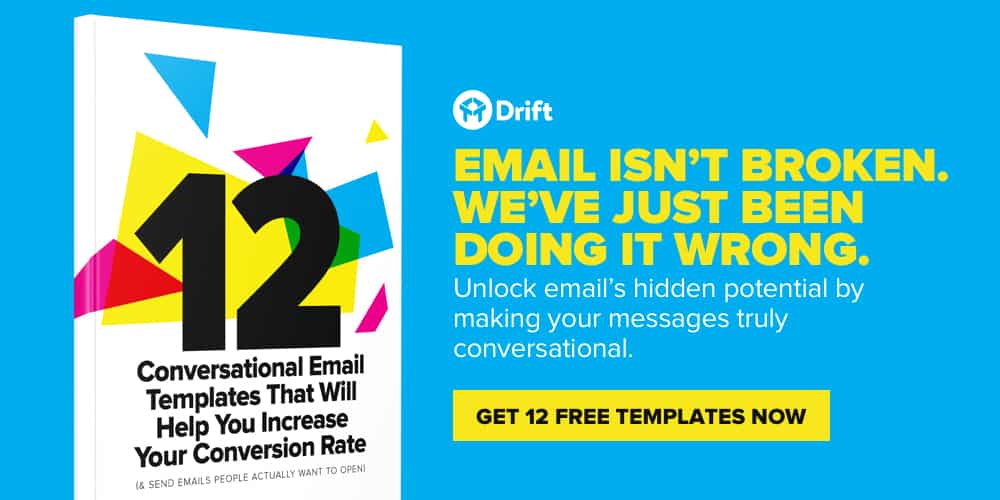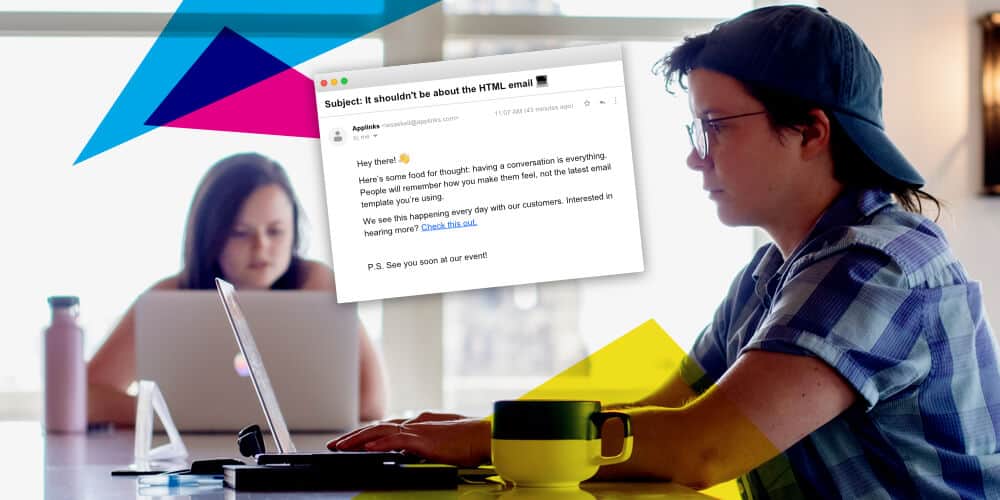
Right now digital communication is more important than ever. In a time when you can’t send direct mail because no one is in their office, when you can’t make calls because people aren’t there to answer their phones, channels like email have become even more important. Here’s how to make your email resonate.
On average, less than three out of 100 people actually click on your emails.
Less. Than. Three.
Why would you settle for that?
I sat down with Ivy Gordon, Sr. Manager of Sales and Onboarding at Unbounce, to talk about the 10 critical elements you need to make sure your email CTAs actually convert.
1. Stick to one CTA in your email
I’ve seen plenty of emails out there with what feels like a thousand CTAs. Look at all the different places you could be clicking – versus one clear simple action.
We all get emails with six links (or more). But THIS is the kind of message that really makes us want to click:
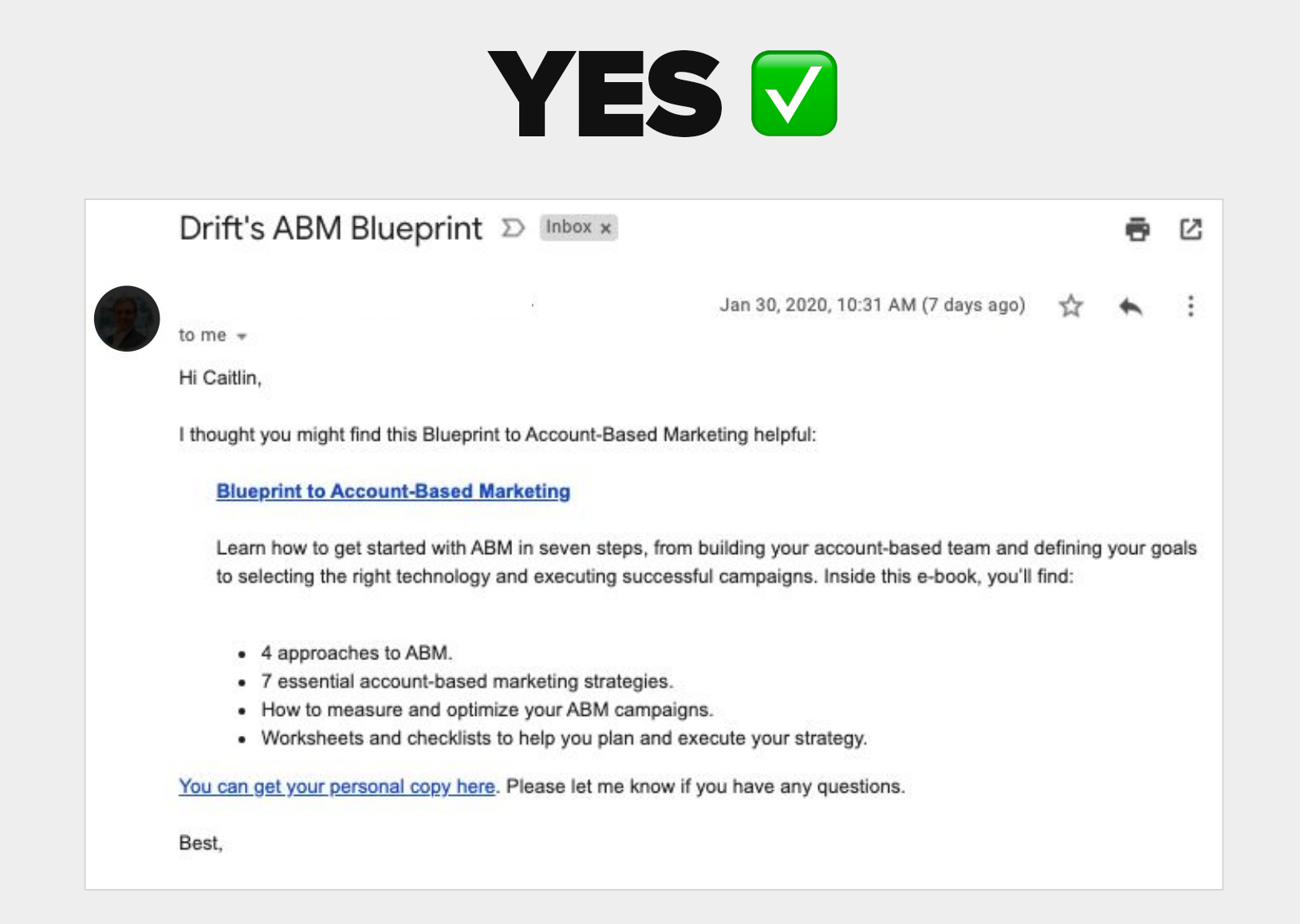
One action, which is to click on the link to the Blueprint to Account-Based Marketing.
The email provides two ways to do that just to make things very, very simple. It includes a few reasons why you should click, but that’s all the information available. It’s better to send an email sequence with one action at a time as opposed to sending one email and trying to get six different results.
2. Create a dedicated landing page for your emails
80% of marketers still send traffic to their homepage. You know what your homepage is like?
Grand Central Station.
For those of you who have never been there, it’s super crowded, busy, and distracting. There are shops! Restaurants! Bakeries! A really cool historical ceiling! Tons of people!
Your homepage is just like that. That’s not a bad thing – it’s built for exploration. On a homepage, the attention ratio could be as high as 57:1, and that’s totally normal.
A landing page, though, should only be built for one thing, with only one button to click. (Yes, even the logo should be unclick-able.) When you build a landing page that’s part of your email campaign, you know exactly how your traffic gets there and what you want them to do.
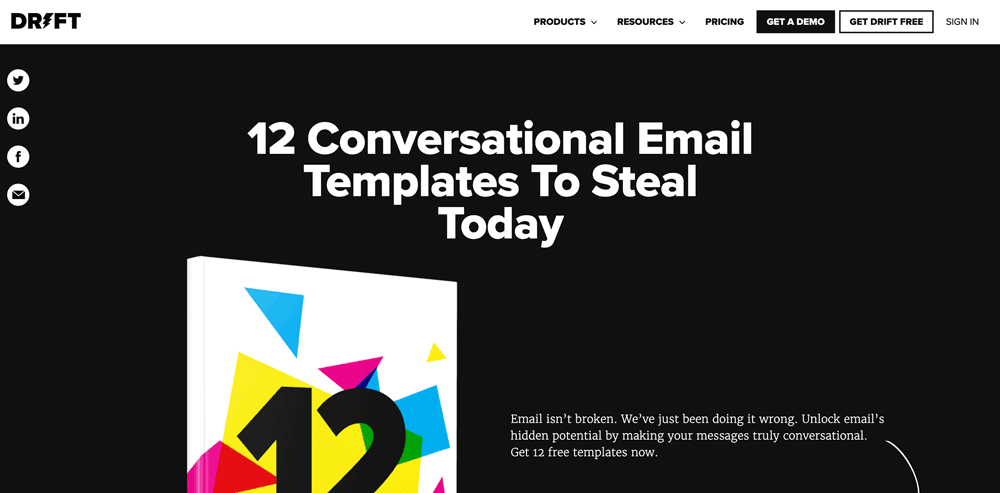
See? One button. One click. One task.
Every single offer you have should have a dedicated landing page, especially if you are sending email traffic or paid traffic to it.
Do this and your attention ratio will be golden.
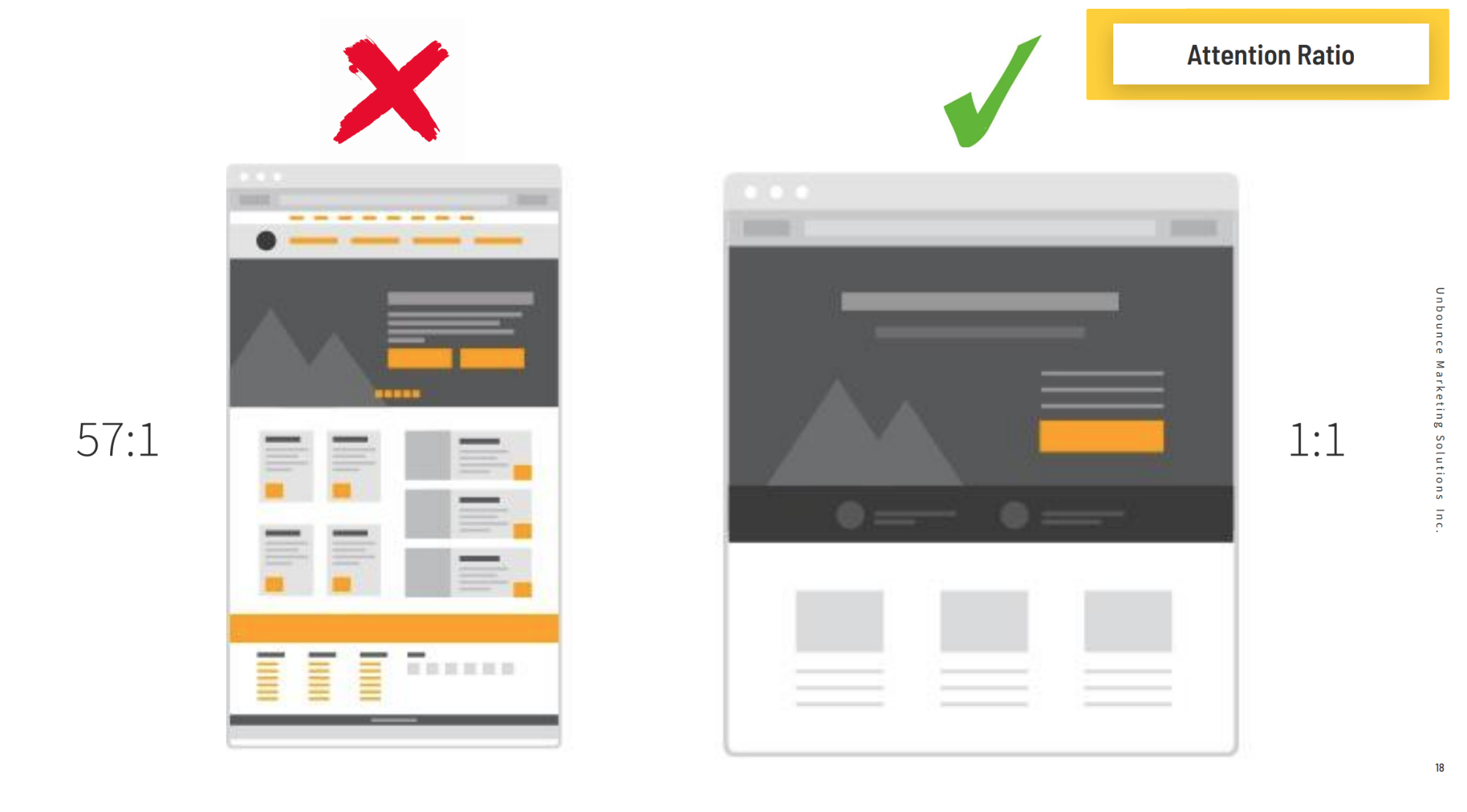
Pro Tip: Attention ratio is the ratio of what someone can do on a given page vs. what you want them to do. Any good marketing campaign should have a ratio of 1:1.
3. Match your messages from email to landing page
If your copy doesn’t match your landing page, you’re disrespecting the click and can expect a high bounce rate.
It’s yet another reason to have a dedicated landing page for offers within your campaigns.
Every time someone clicks through an email, they’re giving you a little bit of trust. What you do with that trust is really important because once it’s gone, it’s gone. No one’s coming back to your landing page thinking, “Actually, you know what? I want to give this another shot.”
Imagine an ad offering a 50% discount for a new laptop. Well, sure, I want 50% off. So I click and all the homepage says is “Welcome to Dave’s Computer Store.” Now I’m thinking, where’s my 50% off? It’s a classic case of the messages not matching up.
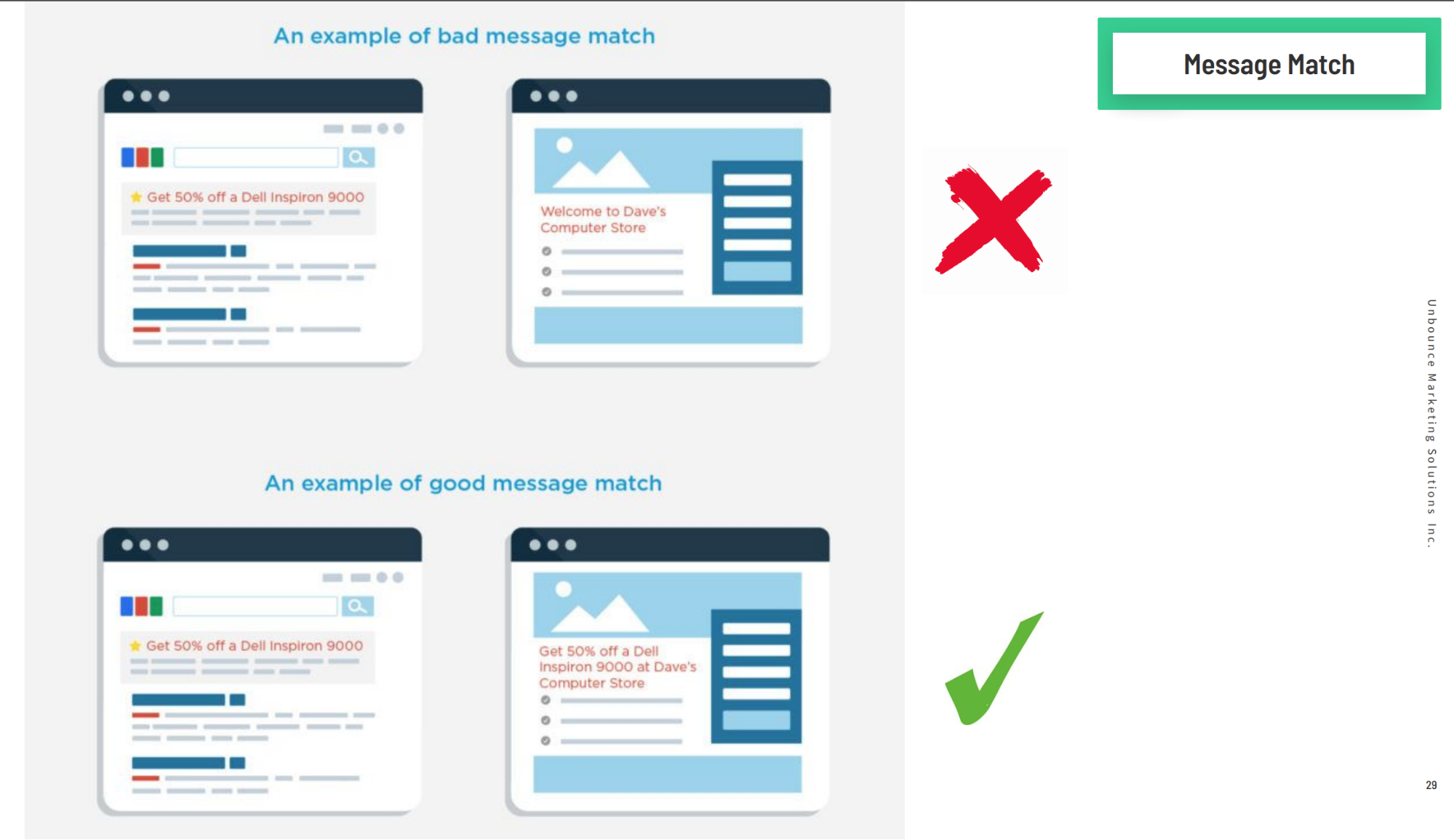
Conversational marketing works really well here. Take this example:
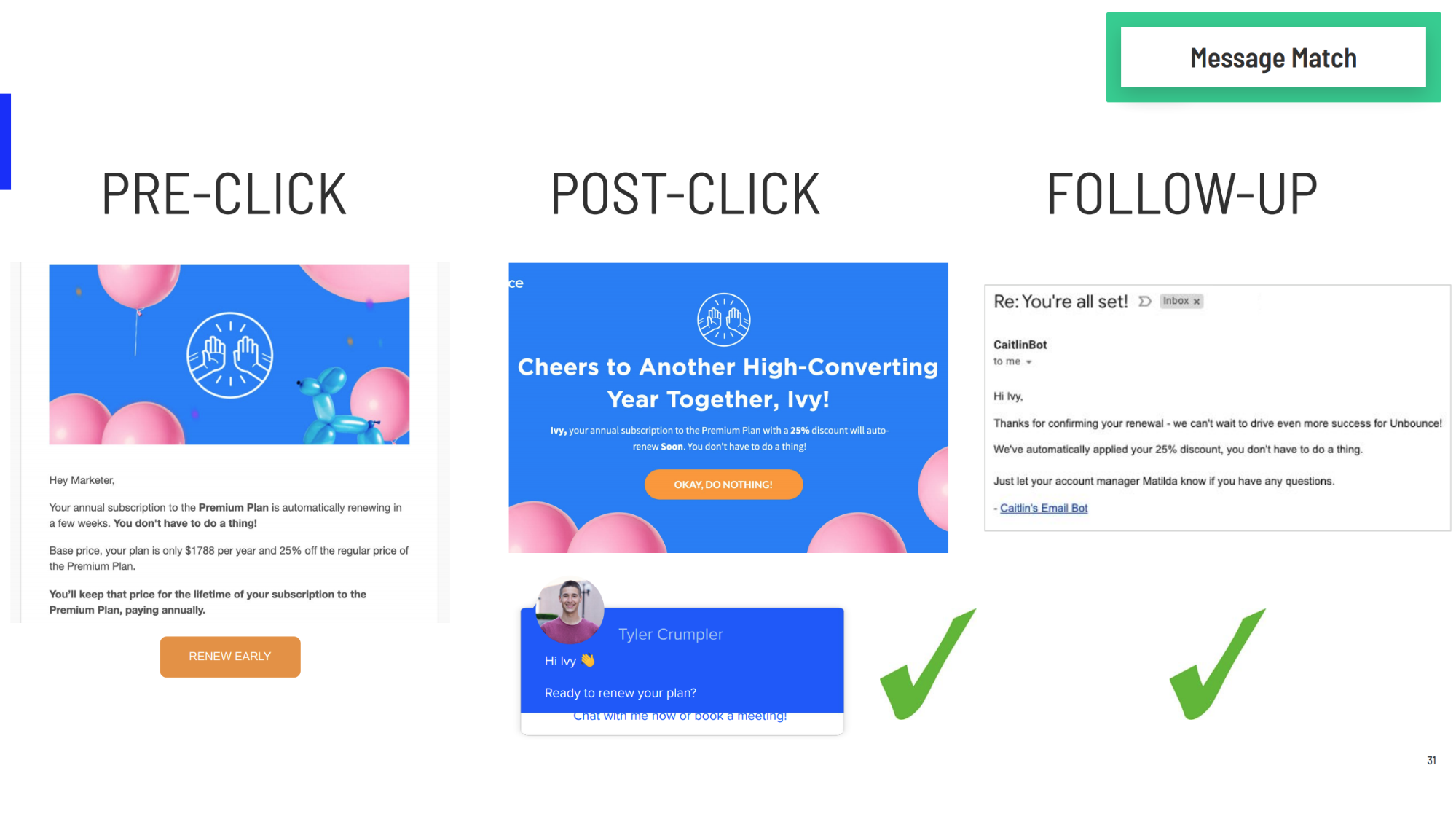 The messages and the imagery match all the way through the flow. Tyler is there and ready to chat with you about renewing your plan so you have two different places you can take the same desired action.
The messages and the imagery match all the way through the flow. Tyler is there and ready to chat with you about renewing your plan so you have two different places you can take the same desired action.
When you message-match, you put the customer first. And it’s way more likely you’ll hit your goals. Win-win.
4. Forget about HTML email
For years, you’ve heard that email is dead.
Email isn’t dead. HTML email is.
Peep some of these stats we pulled from our friends at Campaign Monitor at the end of last year ?
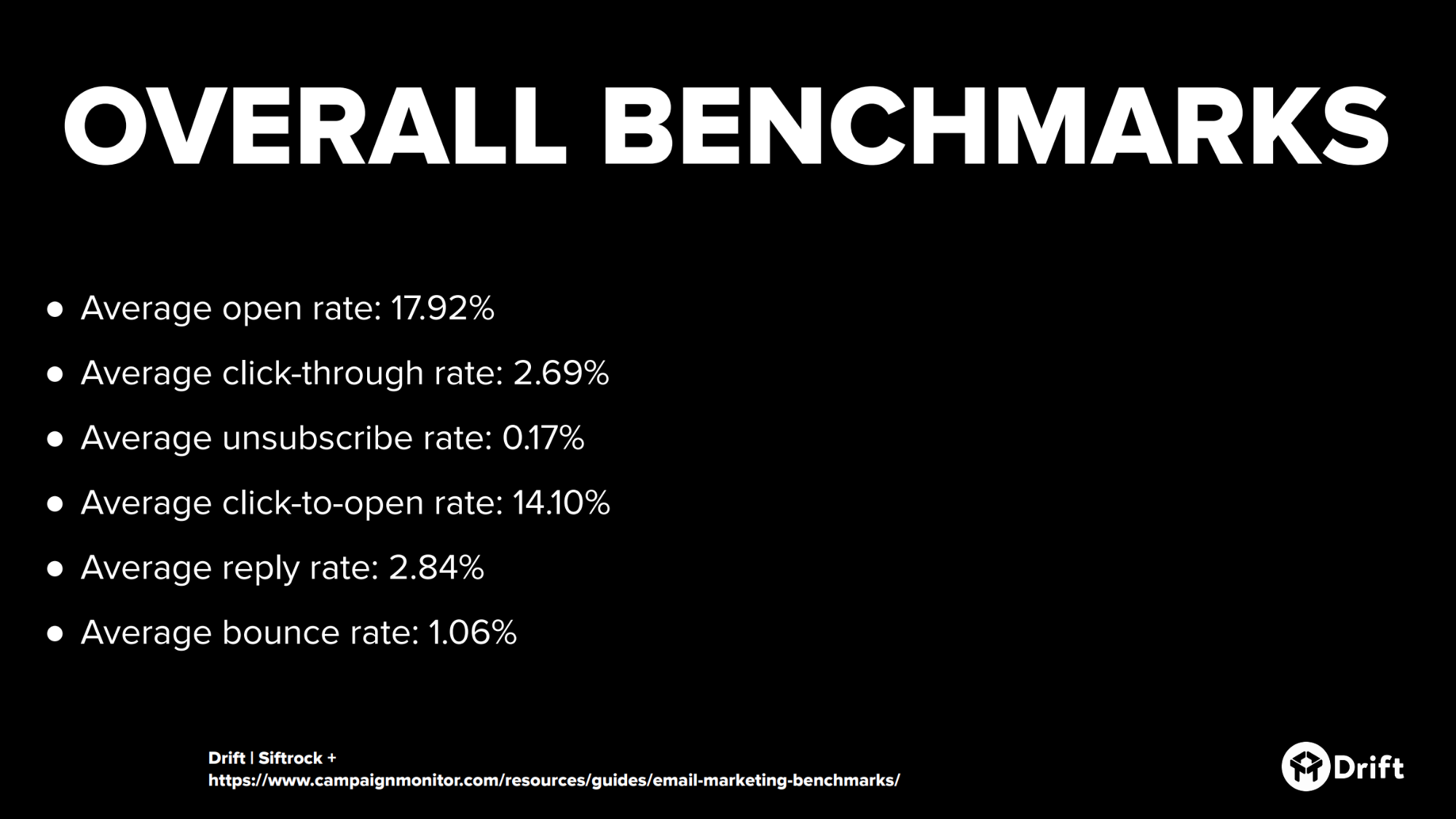
It’s not looking good, folks.
- Overall, the average open rate for B2B tech emails is about just under 18%.
- The average click-through rate is less than 3%.
- Unsubscribes were about 0.17%.
- Click-to-open is about 14%.
Your marketing team spends hours over highly designed HTML emails, worrying over their P-tags, when really, you can achieve better outcomes with simpler, focused emails.
Take a look at this email that got a 71% open rate: ???
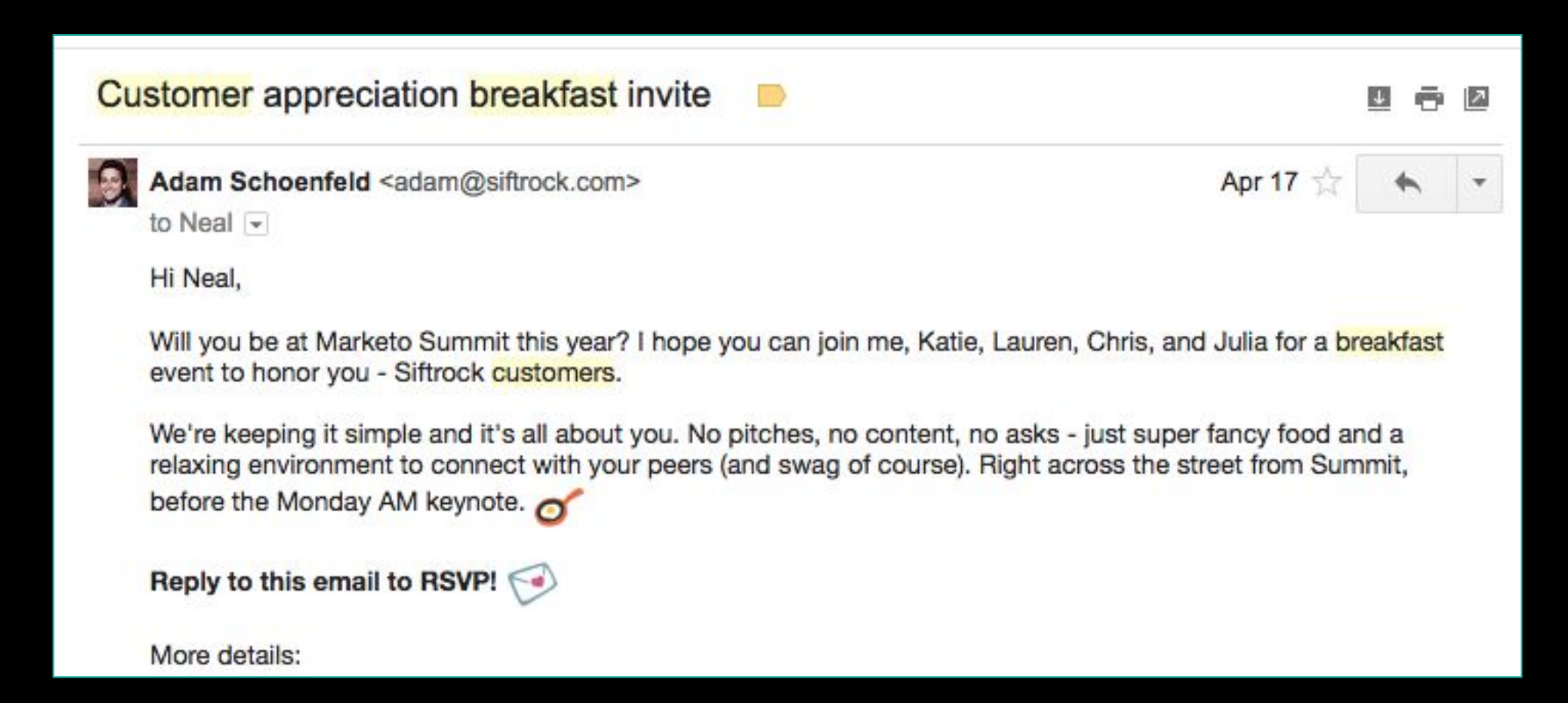
Compare that 71% with 17% average open rate and you’ve got some magic going. But that’s not all:
- The click-through rate of this email was 14%. The average benchmark click-through rate was less than 3%.
- The reply rate on this email was 31% — which is the goal of the email. The average benchmark reply rate was less than 3%.
Why does this stand out?
When the attention ratio goes down, conversion rates go up.
It’s straightforward and personalized. We sent this only to people that we knew that were going to be at Marketo Summit this year for a special appreciation event.
It’s so easy when you get into the thick of creating things to say, “Oh, we could have them do this, and then this, and then we should have them do that. And think about this. And we can add a P.S. for another thing!”
Back away from the computer.
Ask yourself, “Do you need that?”
Do you need a navigation bar on top? Do you need a footer with all kinds of social media links?
What would your emails look like if you optimized for conversion, instead of what you’re “supposed to” include in an email?
5. Capture attention with a unique selling proposition
Whether you’re writing landing page headlines or email copy, you need to include a unique selling proposition. That’s just a fancy name for a clear statement of what you’re offering.
Check out this email example advertising early access to a sweet video series we did with Hiten Shah.
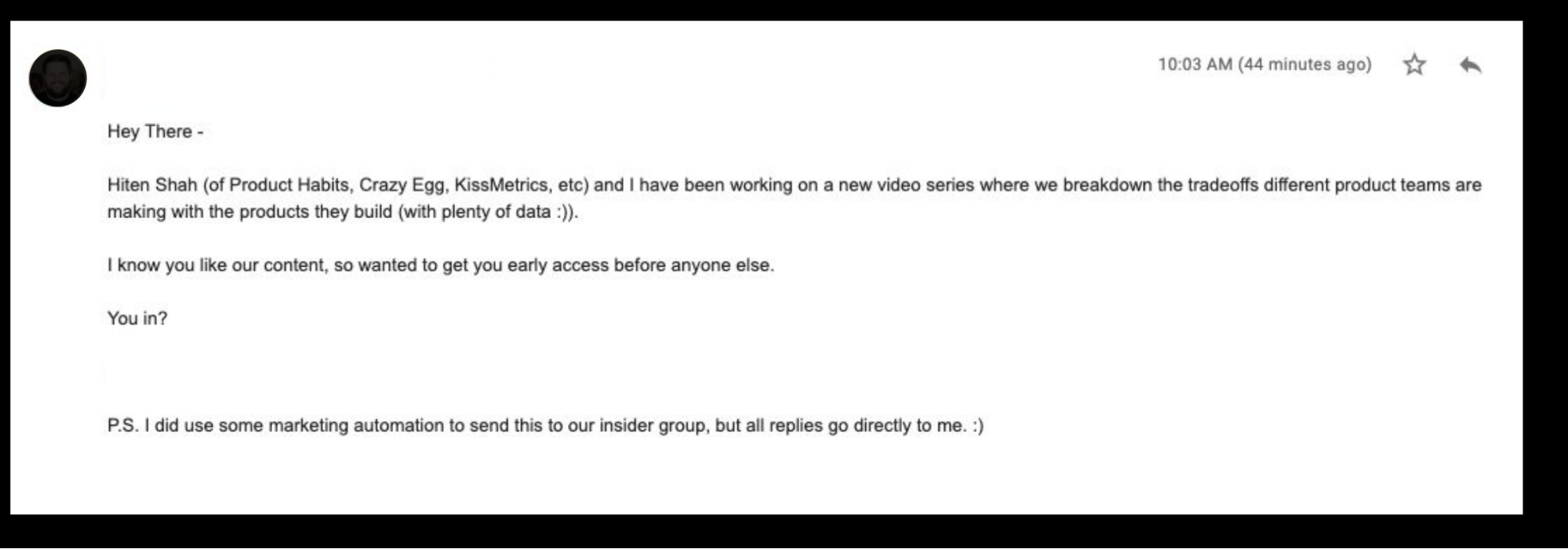
Plus, it looks like an email that’s just coming directly from me. It’s super clear that the offer is for early access to the content. And all my audience has to do is reply to take action on it.
6. Add a human touch
Your hero shot is what adds the human touch to your campaigns. It’s the first image someone sees and it should make your product or service stand out.
Ok, I know I *just* said that HTML email is dead. But that doesn’t mean that you need to just send only text every single time.
Enter the hero shot.
Here’s a great example of what we did last year as a follow-up to one of our events:
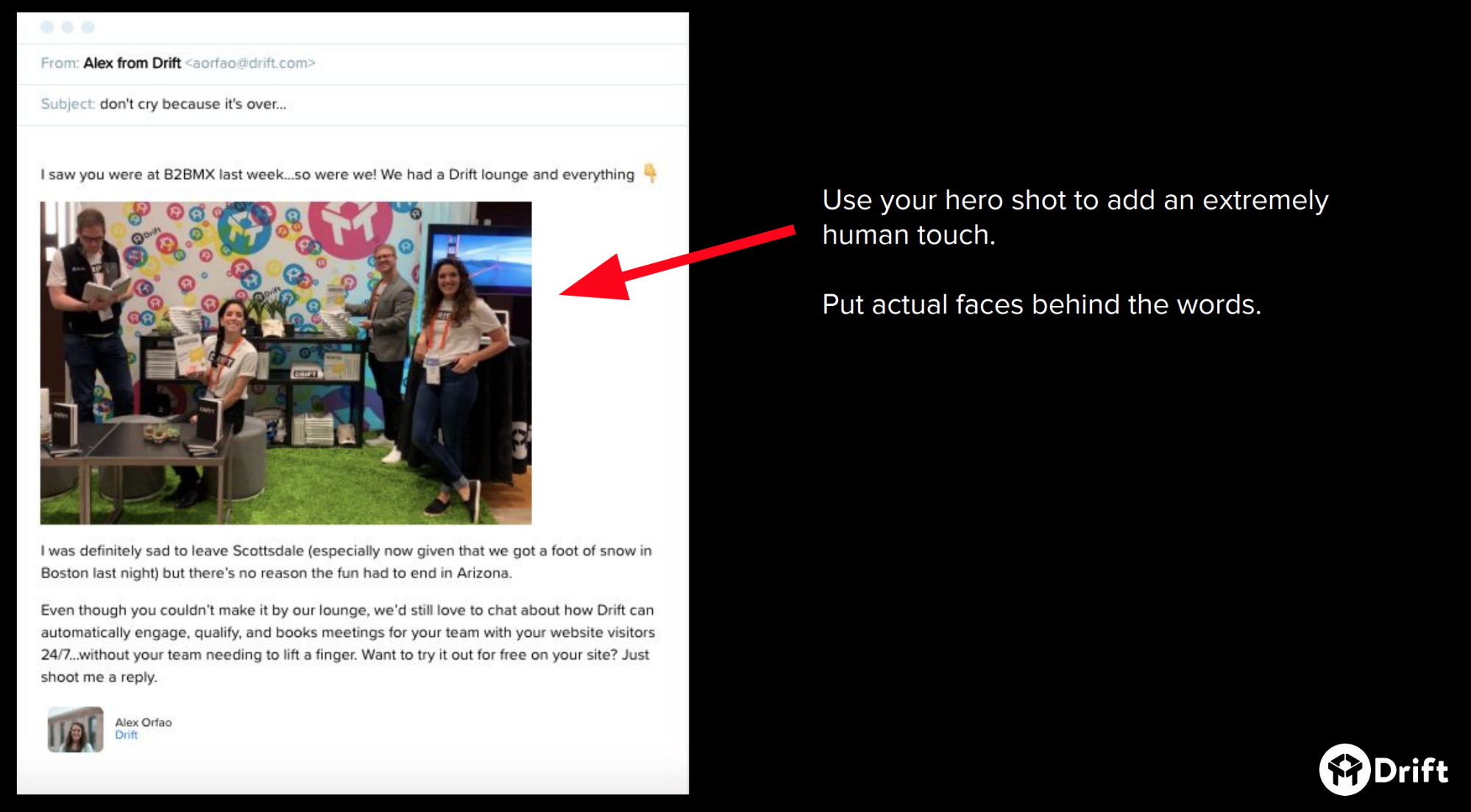
When you go to an event, you can’t possibly remember everyone you talked to and every booth you stopped at. To say nothing of alllllll the follow-up emails you receive.
So we went with a more human touch – here’s a reminder of the people you met, and we loved meeting you. You can see it’s not a fancy, overdone HTML email after all, just a nice image that triggers that recognition from attendees who visited us in our lounge.
Now, more than ever, the world needs to be as human as possible.
7. Identify pain points and address them
To build the “why” behind your offer, you need to attach to the pain your prospects feel. Your features have no meaning if they have no value to the customer.
Identifying the pain allows you to solve it for that person and make it about them, not you.
It’s super easy to list out every single feature and benefit, but a good rule of thumb is to list the three or four supporting features that best match the pain points you’re solving. Don’t talk about WHAT the features do, or HOW the features work speak to how the features come together to provide the solution.
Take this email for example:
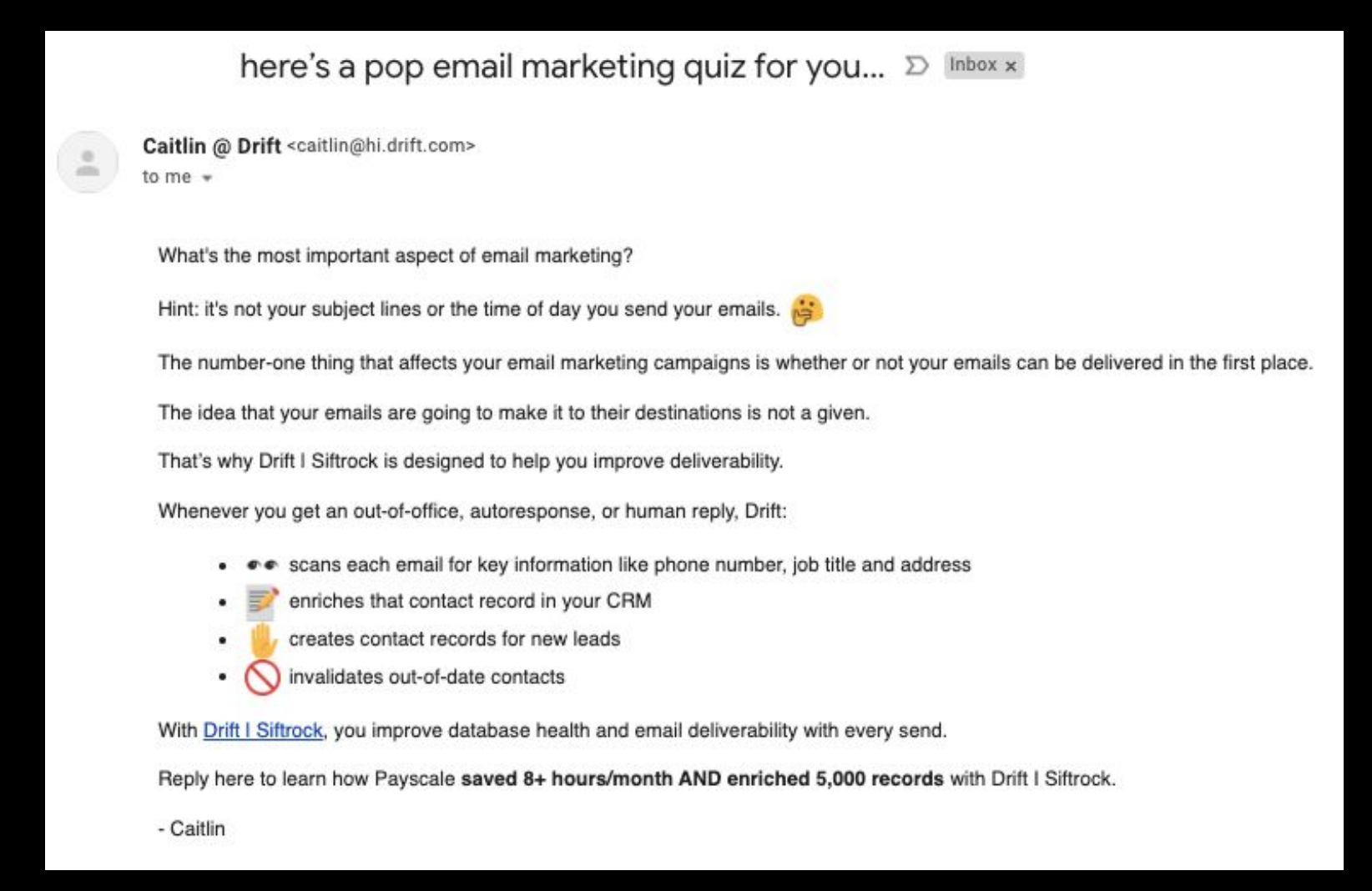
The most important part of email marketing – the most important pain point if you will – isn’t your subject line or when you send your emails. It comes down to your database. It’s not being able to get your emails out to the right people. It’s not being able to see results because your emails are trapped in spam filters. This email connects those two ideas, includes only a few key features, and asks for one action – a reply.
8. Add credibility with social proof
In 2011 there were 150 marketing technology solutions to choose from.
In 2019, there were 7,040.
That’s…a lot.
Your customers have so many choices that they’re more skeptical than ever. You need to show them that you can actually deliver on the promises you’re making to them. Social proof gives them the confidence that you will.
Take this email, for example. PayScale uses Drift Email to get 15 times more ROI on their email marketing program and 11,500 valuable database updates from email replies.

Social proof lends your campaigns a level of credibility. It can be a huge investment for some businesses to make the leap with your product – things like reviews, testimonials, and customer quotes lets them know that it’s a good investment. There’s a reason so many ads nowadays say “Trust over 5,000 five-star reviews.”
It’s because it works.
9. Simplify your ask
You already know the most important part of any campaign is your call-to-action.
So…first question. Do you have a call-to-action? As I mentioned wayyyy back in #1, if you have 7 links, then you don’t have a real call-to-action. You want to make sure that you have one super clear CTA. Like this email:
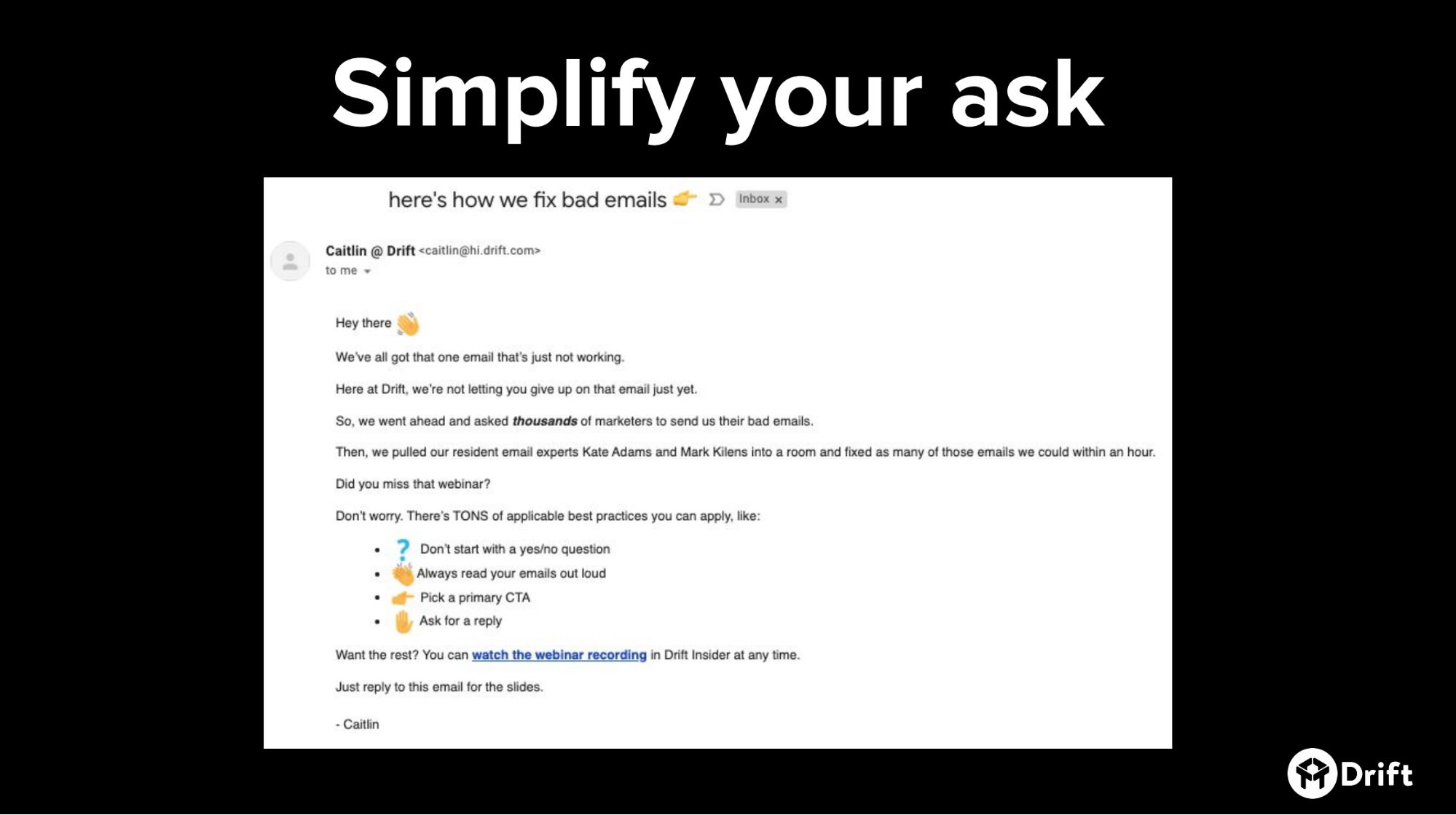
This email ticks all the boxes:
- Identifying pain points: “We’ve all got that one email that’s just not working.”
- Features/Benefits: “There’s TONS of applicable best practices…”
- Social proof: “We asked thousands of marketers…”
- CTA: “Watch the webinar recording.”
But most of all, it’s SIMPLE. One ask. One CTA.
10. Test, test, and test again
Aha, you thought I was done! The CTA isn’t the last part of your campaign – testing and iterating is.
Test, test, and test again is the mantra Ivy lives by, and I gotta say, I do too. If you’re reading through this and you’ve said, “No way am I going to get buy-in for these kinds of campaigns,” then you’re not alone. You have to test it against your audience, because every audience is different.
Looking for your first test? Try more personalized emails. Personalization matters, but how you execute it matters, too. I’m gonna hit you with a few more stats I’ve come across just in case you weren’t sure:
- Personalized emails deliver 6x the transaction rates
- 94% of marketers say personalization is important or extremely important to meet their current email marketing objectives
- Emails with personalized subject lines are 26% more likely to be opened
This is one of my favorite examples of how B2B marketers can learn from B2C. I love to jam out to Lady Antebellum, so Spotify sent me a special thank-you note from Charles Kelley himself:
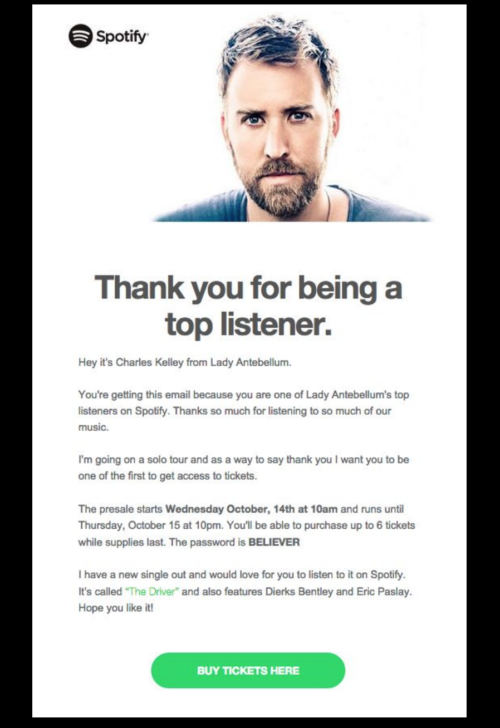
There’s one key CTA here. It’s hyper-personalized because it’s based on my listening history and it’s an offer that I’m more than likely to take them up on.
We Got You
Look, those 10 critical elements are a LOT if you’re starting from scratch. That’s why we put together 12 conversational email templates to help you increase your conversion rate using these ten elements. These are templates that we’ve proven with our own data actually work, and really drive conversion for us.




